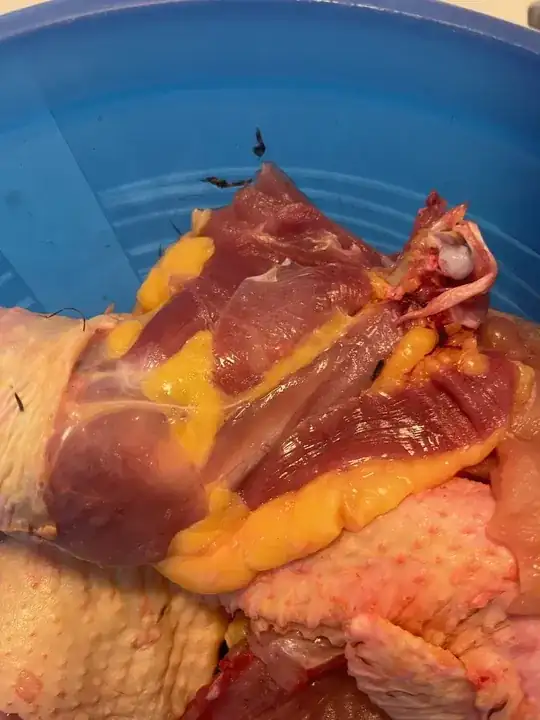This was a Plymouth Rock chicken from my own yard, the first one to be eaten, hopefully. I am not sure about this yellow substance. Is it just fat deposits? Is it normal, and should I just remove them?
-
2It just means your chicken eats naturally and is not fed only grains or pallets. – slebetman Mar 30 '23 at 05:00
-
8This is a beautiful piece of meat, from a well treated animal. Enjoy it! – Vladimir Cravero Mar 30 '23 at 07:17
-
Highly related: https://cooking.stackexchange.com/questions/108939. – rumtscho Apr 01 '23 at 12:25
3 Answers
According to this website (linked below) yellow fat is a good thing! Says it's
"the result of a grass-based diet which is high in chlorophyll.
The cartenoid beta carotene in the grass is the same as the orange colour found in carrots. This is what produces the yellow fat in chickens as well as the bright yellow yolks in pastured eggs."
https://www.dirtycleanfood.com.au/blogs/unearth/why-is-our-chicken-fat-yellow
- 362
- 2
- 3
-
7Please **do not post answers that consist exclusively of copied text** and always *mark* the copied contents clearly. See [here](https://cooking.stackexchange.com/help/referencing) for the rules. – Stephie Mar 28 '23 at 17:37
-
4Had the quote in quotes with a link. Only other thing was author, which isn't stated in the article. So that's the website. Which is in the URL. – J Chant Mar 28 '23 at 17:54
-
3*Strictly* speaking, this answer could be deleted as it is not primarily your work. I will keep it for now (as an explicit exception), as it’s _information_ is correct and helpful. Please remember that for future answers. – Stephie Mar 28 '23 at 18:14
-
2@Stephie where is the rule that says such answers can be deleted? – theonlygusti Mar 29 '23 at 01:32
-
9@theonlygusti a little ironic but Stephie's link does say "Do not copy the complete text of sources; instead, use their words and ideas to support your own. In particular, answers comprised entirely of a quote (sourced or not) will often be deleted since they do not contain any original content." – Journeyman Geek Mar 29 '23 at 02:08
-
2**Comments have been [moved to chat](https://chat.stackexchange.com/rooms/144944/discussion-on-answer-by-j-chant-is-this-yellow-substance-a-fat-deposit-and-is-i); please do not continue the discussion here.** Before posting a comment below this one, please review the [purposes of comments](/help/privileges/comment). Comments that do not request clarification or suggest improvements usually belong as an [answer](/help/how-to-answer), on [meta], or in [chat]. Comments continuing discussion may be removed. – Stephie Mar 29 '23 at 12:35
Home grown, free roaming, chicken can be recognized by those yellow deposits of fat, and by its meat being more firm to the bite, due to the muscles being actually used during the roaming.
Source: I have grown up in a family which used to keep some chickens for laying eggs and then butcher them when they were no longer productive.
The butchered chicken was never as pale as the one we would buy from the local butcher, its fat was never white but rather yellow and, once it was grilled, biting away the flesh from the bones and chewing it needed more effort. But also the taste was way better.
- 955
- 2
- 20
-
1I've bought chicken with these yellow fat deposits in the supermarket but yes, having these is a sign of a high quality chicken that lived a (relatively) happy live. – quarague Mar 29 '23 at 08:13
-
-
1
Poultry and beefs fat get a tinge of yellow when the animal was fed it's natural diet. When livestock are only fed corn then that high-protein powder gives the animal white fat.
Generally, the diet of animal is made clear in the taste of the fat. A lamb from the semi-desert landscape of the Karoo takes to the taste of the desert pepper-bushes.
The lambs from the grasslands of the North-West province have a much milder and agreeable taste to there fat.
In general practice you will not see the yellow fat often, because corn base diets of livestock brings them to slaughtering weight much quicker.
In the case of beef it is difference between tending to an animal for three years or tending to it for five years before you get money for it.
With the margins in poultry farming being so razor thin, you will not get yellow fat from anything but the highest quality of free range poultry.
There is a growing movement in South Africa where people are getting more involved with how the food they consume is produced.
More and more people are willing to pay extra for grass-fed beef and yellow chicken. It is good to see. Your body is your temple. You should not pollute it with anything like a battery chicken.
- 4,573
- 8
- 35
- 58
-
May I suggest emphasizing the degree of yellowness? All the chickens I've ever bought have had yellow fat, possibly due in part to getting things like marigold petals in their feed, but none have had fat that's as deeply yellow as the OP's photo shows. – Caleb Mar 31 '23 at 16:17
-
-1 for making improper generalizations. The question wasn't about lambs. In chicken, 1) corn is not an unnatural diet, and 2) corn is what makes it yellow, and is considered a sign of quality. See also https://cooking.stackexchange.com/questions/108939. – rumtscho Apr 01 '23 at 12:25
